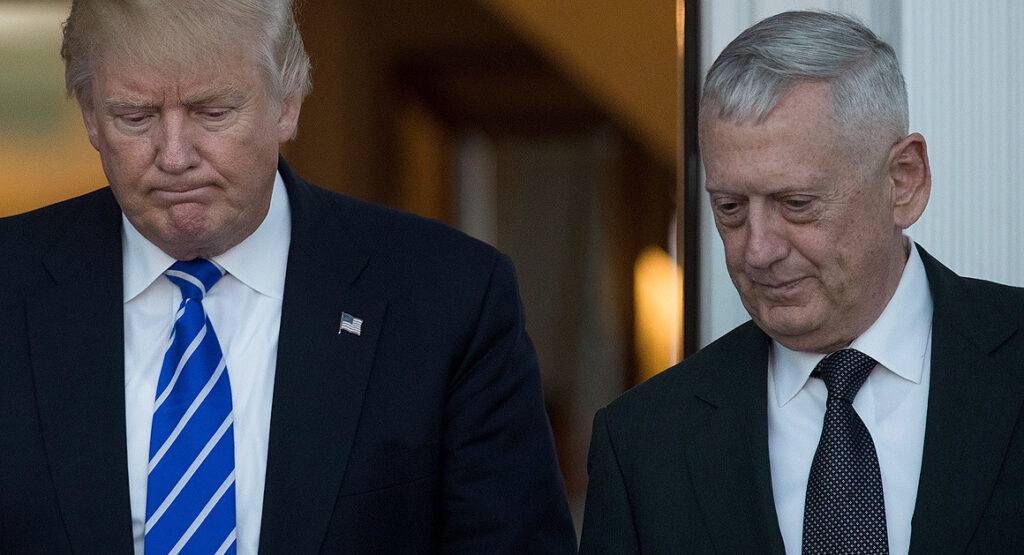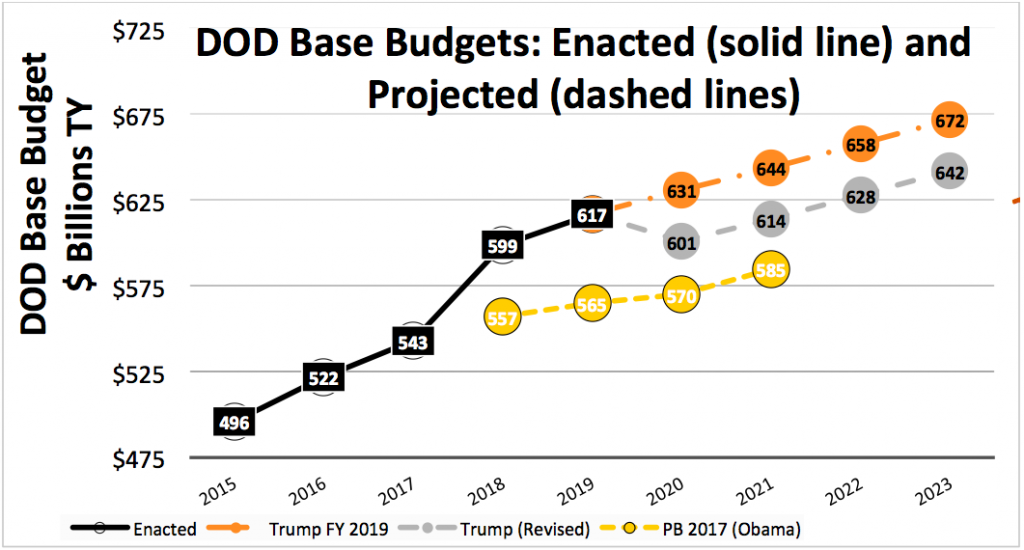Mattis Vs. Mulvaney: The Coming Budget Clash & The Reagan Legacy
Posted on
In the next few days, Defense Secretary Jim Mattis and budget director Mick Mulvaney will face off in front of President Trump about the size of the defense budget. As deficit concerns clash with national security, a Trump decision in favor of Mulvaney could force a less assertive strategy and steep cuts to modernization programs.
We have been here before. In 1982 Caspar Weinberger, then-Secretary of Defense, and David Stockman, then-director of the Office of Management & Budget, had a similar showdown. DOD won that time. What does that have to tell us about the impending Mulvaney–Mattis showdown? And if OMB wins this time, would Mattis stay on?
Why a showdown now?
Last month President Trump was briefed by his economic team and awoke to the challenge of deficits, which are large and rising. The projected deficit for FY 2019 is over $1 trillion, according to the Congressional Budget Office, and will continue to grow as baby boomers retire and interest rates increase from the historic lows of the post-recession decade. Total debt owed to the public will reach 100 percent of GDP in 2030, the level many economists use as a benchmark for economic trouble.
And all this is happening even though the economy is booming, and deficits should be falling. When the next recession hits, as it inevitably will someday, deficits will explode, and there will be little cushion to absorb them.
Alarmed by these projections, Trump directed a five percent cut in domestic spending and a $700 billion defense budget (which included the base budget plus war funding plus the nuclear elements of the Department of Energy, called “050” in Congressional budgeting). This represented a $33 billion or 4.5 percent cut from the previous plan of $733 billion.
The cuts caught everyone by surprise because OMB had not prepared the ground with papers or analyses. Mulvaney simply relayed the lower guidance to DOD as its new planning target.
The DOD has thus produced two budgets, at $700 billion and $733 billion. Although Mulvaney was not, apparently, the source of the cuts, he is likely supportive. As a member of Congress, he had been a strong deficit hawk and skeptical of all government spending. Further, he apparently believes that the decision has been made and that the lower number is the administration’s position.
Sec. Mattis has been clear that he opposes the lower defense budget. Last January he published a National Defense Strategy that was very forward-leaning, arguing that, “Without sustained and predictable investment to restore readiness and modernize our military to make it fit for our time, we will rapidly lose our military advantage, resulting in a Joint Force that has legacy systems irrelevant to the defense of our people.” Just last week, in his keynote address at the Reagan National Defense Forum, he stated that “without sustained, predictable funding, the gains we’ve made will fade, and our investments will never realize their full potential.” So Mattis will appeal for the higher number.
And Mattis might change the president’s mind. In any administration, the secretary of defense is one of the few cabinet members who can appeal directly to the president — and, despite persistent rumors of his departure, Mattis in particular has always seemed to be one of the few people Trump deeply respects.

President Reagan listens to arguments on the 1984 budget. Defense Secretary Caspar Weinberger sitting next to Reagan — budget director David Stockman is across the table with his back to the camera.
Deja vu all over again
There are strong parallels to the 1982 Weinberger–Stockman showdown, which occurred when it became clear that balancing the budget was not going to be achievable with the current policies. The Reagan administration’s previous projections had shown a balanced budget in the future but that projection relied on what was called the “magic asterisk” — a footnote on massive “future efficiencies to be identified” — and the “rosy scenario” — very favorable economic projections.
Neither materialized. By 1982, it was clear that large efficiencies were not going to be achievable because the administration had used all its political capital on tax cuts and the defense buildup. The rosy scenario unraveled as economic performance deteriorated as a result of anti-inflation measures (which were eventually successful but hurt near-term budget projections). Stockman wanted to cut defense as one step in curbing deficits.
So Stockman and Weinberger made their cases in front of Reagan at a meeting at the Reagan Ranch. Stockman presented the usual tables with complex economic projections. Weinberger presented what has been called the “big soldiers, little soldiers” briefing to make his point about the need to continue the defense buildup. In the graphics, the Weinberger program produced “big soldiers,” literally a larger sized soldier on the graph, while the Stockman budget produced “little soldiers,” a smaller sized soldier on the graph. The same went for ships, aircraft, and munitions.
Stockman called the presentation “intellectually disreputable,” but Weinberger won the argument. So the defense budget continued increasing, and the administration accepted the growing deficit.
Stockman arguably had the last laugh, however: Congress, finally alarmed by the rising deficits, imposed the Gramm-Rudman-Hollings legislation in 1985 (revised in 1987) that gave us “sequestration” and PAYGO, both of which are still with us.
What can Secretary Mattis learn from the previous showdown?
The first is the presentation matters. Talk about strategy, risk, and the international world order is fine for context, but listeners latch on to concrete details. Mattis should dramatically show what will happen to the 355-ship Navy, the modernization program, and troop benefits under the $700 billion a year strategy. Normally, a secretary would also lament the reduction of commitments to allies and partners, but Trump might regard that as a feature, not a bug, given his skepticism of alliances.
A second insight is that it is possible to win the battle and lose the war. Arguably, that’s what happened to Weinberger, who won the argument in 1982 but helped produce an environment where budget caps became common. Mattis argues that focusing on defense and discretionary spending is misplaced because they are only a small part of the total federal budget. He is correct on the economics. As the CBO chart shows, the rise of mandatory spending (“entitlements”) and interest payments causes the increase in federal spending. Discretionary spending, both defense and domestic, will decline as a percentage of GDP.
But However, Mattis is wrong on the politics. It will be hard to make a budget deal that significantly reduces the deficit without including all elements—discretionary, mandatory, and revenue. Republican efforts to reduce deficits with spending cuts and Democratic efforts to do the same with revenue enhancements have both failed. That’s why it’s surprising that Trump gave away his strongest budget card, the defense buildup, without getting anything from the Democrats in return. Mattis should push the president to make a broader deal if defense is going to be cut. Fiscal sustainability would protect future defense budgets, even if at a lower level.
What if OMB wins this time?
Trump appears to be less committed to defense spending than Reagan. In fact, he just tweeted that the amount of defense spending was “crazy.” So, the budget decision could very well go against Mattis and DOD.
In that case, it’s hard to believe that Mattis would continue as secretary of defense. Just 11 months ago, Mattis warned that “our competitive military advantage has been eroding” and that “sustained and predictable investment to restore readiness and modernize our military” was required. It is hard to imagine that he would now walk that back and argue that the same forward-leaning strategy could be achieved with fewer resources.
This may be a pivotal moment. A $700 billion national security budget can do a lot, but it can’t fund the strategy laid out last January. Other people might make great secretaries of defense, but Mattis has been a steadying influence during a time of great uncertainty and turbulence in the White House. Stay tuned.
Subscribe to our newsletter
Promotions, new products and sales. Directly to your inbox.







